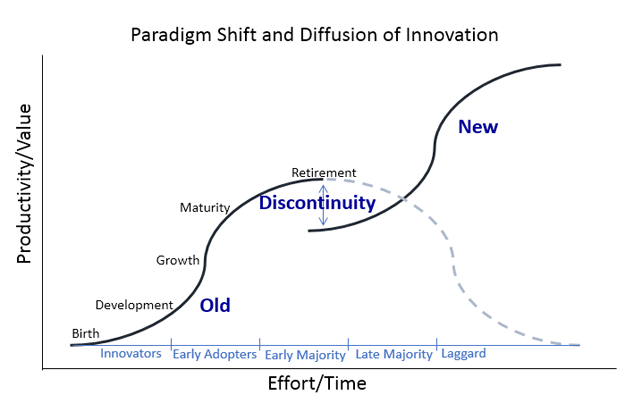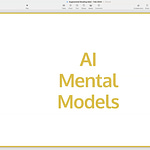Video Clip Source: Independent researcher, author, and filmmaker Joel Barker, in Discovering the Future: The Business of Paradigms documentary.
Author Note: Over the last 5 years, I’ve spent thousands of hours collecting, studying, and teaching the world’s most useful and universal mental models in my Mental Model Club. I may have spent more time studying mental models than anyone else in the world. IMHO, paradigm shifts are one of the top 10 most power mental models to learn. And they’re particularly timely in the age of AI.
Free subscribers get the equivalent of a mastery manual that will help you understand, navigate, predict, and create paradigm shifts across your life.
Paid subscribers get:
20-Page Paradigm Article Template & Worksheet For Thought Leaders. This worksheet took me years to make through trial and error. It will help you understand the step-by-step points you need to make in order to help someone have a paradigm shift. It includes case studies and instructions.
Full access to my Paradigm Shift AI Bot. To write this article, I used Augmented Reading to collect the best 18 academic studies, interviews, speeches, and books on paradigm shift. Then, I customized the bot to help me probe the body of work. You can use this bot to go deeper on paradigm shifts and/or simply use it for inspiration to create your own bot.
The future does not always look like a better version of the past.
Sometimes, it slows from a sprint to a walk to a freeze, like a train screeching to a halt.
And more often than not, it's like a caterpillar transforming into a butterfly:
A metamorphosis that ushers in a new paradigm filled with new players, values, dynamics, strategies, technologies, business models, form factors, and other unprecedented possibilities.
I’ve been thinking about paradigms a lot recently, because we’re on the cusp of a major paradigm shift when it comes to AI broadly and reading books specifically. Among many other things, this new paradigm will fundamentally change our knowledge society:
How readers discover, summarize, integrate, synthesize, and use information
How thought leaders create and monetize their work
Over the years, I’ve found studying paradigm shifts not only helpful for situations like our current AI paradigm shift, but also extremely helpful across my life…
5 Ways That Paradigm Shifts Have Changed My Life
In short, paradigm shifts have helped me:
Become a better innovator
Predict how major paradigm shifts will play out
Become a better thought leader
Understand the paradigmatic stages of my own life so I don’t get stuck
Prepare for paradigmatic shifts in order to be resilient and make better decisions
Here’s how…
#1. Become a better innovator
Over my life, I’ve been particularly inspired by top innovators and scientists. For example…
Isaac Newton's Laws of Motion and Universal Gravitation
Albert Einstein's Theory of Relativity
Charles Darwin's Theory of Evolution
Elon Musk pioneering new paradigms of possibility in electric vehicles and private space exploration
To a T, these innovators create new paradigms that transform the world. Therefore, I’ve learned a lot by understanding how they observe, experiment with, and challenge conventions. Their values, techniques, frameworks, etc., are completely different from those of people who focus on succeeding within an existing paradigm.
#2. Predict how major paradigm shifts will play out
Paradigm shifts follow predictable patterns that have been studied for nearly 100 years. Therefore, we don’t need to think from scratch about what will happen. We can make very educated guesses.
More on these patterns later in the article.
#3. Become a better thought leader
I’ve always been inspired by writers who don’t just share tactics, but who share entire philosophies and paradigms that change how I see reality.
As a thought leader, I endeavor to have the same impact on others. So, I’ve spent a lot of time reverse-engineering what it means to write a paradigmatic article.
#4. Understand the paradigmatic stages of my own life so I don’t get stuck
Finally, understanding paradigms has helped me navigate to new stages of personal growth rather than being the victim of my own success in a paradigm and resist change.
By understanding the stages of human development and how the paradigms shift between them, I’ve been able to better anticipate, contextualize and resolve challenges as they come up.
For example, understanding paradigms helped me move from a paradigm where I defined success by external achievements to a more holistic paradigm of achieving and experiencing from a foundation of aliveness, fullness, personal growth, and wisdom.
#5. Prepare for paradigmatic shifts in order to be resilient and make better decisions
Paradigm shifts trigger 10+ cognitive biases (read more about paradigm shifts and cognitive biases):
Negative Learning Transfer
Theory-Induced Blindness / Paradigm Blindness
The Backfire Effect
Availability Bias
Anchoring Bias
Confirmation Bias
Status Quo Bias
Conformity Bias
Sunk Cost Fallacy / Loss Aversion
Groupthink / Ingroup Bias
Not Invented Here (NIH) Syndrome
Temporal Discounting (we value short-term over the long-term)
Tangible Bias (we value and understand certainties over probabilities)
This is a big deal because biases going in the same direction can add up to create extreme emotions and irrational decisions. The late self-billionaire Charlie Munger, Warren Buffett’s business partner, explains…
Lollapalooza effects occur when there are multiple forces or factors moving in the same direction. The key is that when forces combine, they don’t just add up; each force builds off of and strengthens the other, creating an explosive effect with huge results.
—Charlie Munger
By being aware of these biases and the emotions they trigger, I can better prepare for and adapt to paradigm shifts.
Why Paradigm Shifts Are More Important Than Ever
In Google Director Of Engineering: This is how fast the world will change in ten years, I spent 60 hours studying rates of change in society and what it means.
One of the big ideas that hit me from this research is this quote from renowned futurist and Google Director Of Engineering Ray Kurzweil:
“My models show that we are doubling the paradigm-shift rate every decade.”
— Ray Kurzweil
This statement is profound because it means the following…
To put this chart in context, 20 years from now, the rate of change will be 4x what is now. Said differently, for someone who is about 40 today, when they’re 60 in 2040, the rate of paradigm change will be 4x what it is now. They will experience a year of change (by today’s standards) in three months. For someone who is 10 today, when they’re 60, they’ll experience a year of change in 11 days.
To summarize the profundity of this 10-year doubling rate, Kurzweil says…
“We won’t experience one hundred years of technological advance in the twenty-first century; we will witness on the order of twenty thousand years of progress (again, when measured by today’s rate of progress), or about one thousand times greater than what was achieved in the twentieth century.”
Bottom line: The more that the paradigm shift rate increases, the more important it is to understand the dynamics of paradigm shift. Previously, someone could go to college and reliably spend their whole career in the same industry at the same company using the same knowledge in the same paradigm. Now, all of these change every few years.
With that said, let’s dive into the nitty-gritty of paradigms…
Independent Researcher Joel Barker Explains Paradigms
A paradigm is abstract to explain. It’s also invisible to most people. Therefore, there aren’t many good explanations of them.
This section aims to correct that.
In my opinion, the best explainer of paradigm shifts in the business context is independent researcher, author, and filmmaker Joel Barker. In 1985, he released his classic book Paradigms: The Business of Discovering the Future, which I highly recommend:
A year later, he released a full documentary on the topic called Discovering the Future: The Business of Paradigms. By 1988, it was the best-selling business video in history. This documentary is where I got the video clip above by the way.
The quote below from the documentary captures what a paradigm is on a fundamental level:
Paradigms are sets of rules and regulations that do two things:
First, they establish boundaries. In a sense, that's what a pattern does. It gives us the edges, the borders.
Second, these rules and regulations then go on to tell you how to be successful by solving problems within these boundaries.
This quote succinctly defines the dual role of paradigms:
Setting the framework within which we operate.
Guiding behavior within that framework.
According to Barker, the types of rules and regulations that make up a paradigm can be categorized as:
Frameworks
Tools & Techniques
Norms
Language
Success Criteria
Rules of Interaction
Collectively, these rules and regulations are the invisible water that we swim in. The filter we look through that determines what we see and don’t see. The compass that guides us.
Below is a deeper dive into each aspect of a paradigm:
Frameworks: Paradigms are defined by frameworks that guide inquiry, interpretation, and what is valid or valuable overall. These rules frame how we think about problems and solutions and what we consider to be knowledge or truth. For example, in business, the concept of supply and demand governs how markets operate. In science, the theory of relativity reshaped our understanding of space, time, and gravity.
Tools & Techniques: In both business and science, paradigms include the procedures deemed appropriate for achieving goals or conducting research. In business, operational rules might include lean manufacturing techniques. In science, the scientific method dictates the steps for conducting research. These operational rules dictate the 'how-to' playbook within the paradigm.
Norms: These are the widely accepted beliefs, values, and standards that guide behavior in a given context. In culture, this might include social norms and ethical standards. In business, it could involve best practices, industry standards, and corporate ethics. In science, it refers to standards of evidence and justification.
Language: Paradigms also encompass the language and symbols used for communication within a field. This includes the specific jargon in science, the business lexicon in the corporate world. Business language might include terms like ROI (Return on Investment) whiles science uses technical terminology like 'quantum entanglement'.
Success Criteria: In any paradigm, there are specific ways success is measured, whether it’s profit and market share in business, experimental validation in science, societal impact in culture, or personal achievement in life. These criteria set the goals and objectives within the paradigm and determine what is valued and rewarded.
Rules of Interaction: This includes the implicit and explicit rules governing interactions among individuals and groups within a field. In a business setting, this might refer to corporate hierarchy and leadership styles. In science, the peer review process and academic hierarchy. In culture, social hierarchies and interaction norms.
Most of the time, most people don’t actually need to think about paradigms much. We’re in the middle of a paradigm and things are working. However, understanding paradigms is absolutely critical when a paradigm shifts, and suddenly, the paradigm we live in feels more like a cage than a spacious world to explore.
Now that we understand paradigms on a theoretical level, let’s explore paradigms on a more concrete level…
Examples Of Paradigm In Action Across Multiple Domains
Now that we understand paradigm shifts on a concrete and theoretical level, let’s explore how to navigate, predict, and capitalize on these shifts.
To do this, let’s start off by exploring what makes them so hard. As longtime readers know, I’m a big believer in the following quote:
A problem half-understood is a problem half-solved.
—Charles Kettering, former head of innovation, GM
Paradigm Shifts Are Hard To Navigate Because They’re Hard To See, Are Emotionally Triggering, And Are Confusing
First, paradigms are hard to see.
And it’s hard to change what we can’t see. Barker explains in the video clip:
Kuhn discovered that paradigms act as filters that screen data coming into the scientist's mind. Data that agrees with the scientist's paradigm has an easy pathway to recognition. In fact, scientists see that kind of data amazingly well with great clarity and understanding. And that's good.
But Kuhn also discovered a startling negative effect with some of the data scientists had substantial difficulty. Why? Because that data did not match the expectations created by their paradigms. And in fact, the more unexpected the data was, the more trouble the scientists had perceiving it. In some cases, they simply ignored the unexpected data. Sometimes they distorted that data until it fit their paradigm, rather than acknowledge that it was an exception to the rules. And in extreme cases, Kuhn discovered that scientists literally, physiologically were incapable of perceiving the unexpected data. For all intents and purposes, that data was invisible.
To put it in more general terms, paradigms filter incoming experience. We are viewing the world through our paradigms all the time. We constantly select from the world that data that best fits our rules and regulations, and try to ignore the rest. As a result, what may be perfectly obvious to a person with one paradigm may be totally imperceptible to someone with a different paradigm
I call this phenomenon The Paradigm Effect.
And I have seen repeatedly that what Kuhn describes for scientists is true for anyone who has strongly held rules and regulations in their lives. And who doesn't?
In my work with companies around the world, I have seen this Paradigm Effect blind business people to new opportunities, cause salespeople to overlook new markets, obscure effective strategies from management, and it can blind each and every one of us to creative solutions to difficult problems, whether it's the Army or the environmental movement, the American Medical Association or the League of Women Voters, whether it's Citibank or IBM, the coach's way to hit the ball or mom's way to clean the kitchen. We deal with paradigms all the time, and I believe that it is our rules and regulations that keep us from successfully anticipating the future, because we try to discover the future by looking for it through our old paradigms. And so in the 1960s, we looked forward and concluded, cheap gas forever for children make an ideal family. Cable television will never catch on Japanese products will always be junk. And boy were we wrong. And we were wrong because our paradigms had the power to keep us from seeing what was really happening.
To summarize…
Paradigms literally alter our perception, making certain things invisible or distorted, which ultimately leads to poor decision-making and innovation.
Second, paradigm shifts are emotionally triggering.
They take us out of our comfort zones and force us to contend with ideas and situations that are difficult. Many of us naturally recoil when something is uncomfortable. Resistance to an idea that challenges a paradigm can be so strong that the individual is jailed or even killed. For example, Galileo was formally banished by the Roman Catholic Church for his crazy theory that the Earth orbits the Sun.
Finally, paradigm shifts are confusing.
A great metaphor for the difficulty of adapting to paradigm shifts is trying to learn how to ride a backwards bicycle and having more trouble learning than someone learning from scratch. Because in order to learn how to ride a backwards bicycle, the rider first must unlearn bad habits step-by-step.
Source - The Backwards Bicycle: What it takes to Unlearn Old and Learn New Habits
Similarly, when a paradigm shifts, a lot of the rules and regulations from the previous paradigm can actually hurt us in the new paradigm. This is where the phrase, “What got you here, won’t get you there,” comes from.
Joel Barker adds further texture:
You will make a perfectly rational mistake: You will assume that sooner or later the paradigm you are presently practicing (which has been mostly successful) will solve all the rest of your problems.
—Joel Barker
Now that we understand what a paradigm is and why it’s beneficial to learn about now, let’s understand the stages of a paradigm shift…
Understand The Stages Of Paradigm Shifts Helps You Navigate Them
By understanding the stages of a paradigm shift, we can better notice where we are and where we’re going.
Paradigms are typically visualized with S-Curves with the following stages…
Stage #1: Infancy
A small number of “crazy” people
Observation of anomalies that can’t be explained by the old paradigm
Lots of experimentation
Not much progress
Stage #2: Expansion
Hype cycle followed by growth based on results
Experiment(s) work
Previously unsolved problems can be solved
New theories are developed
New techniques and tools are used
Exploration of everywhere this new paradigm can be used
Stage #2: Maturity
Growth slows
Limits of the paradigm are identified
Openness to a new paradigm increases
Next, these paradigms overlap each other and often co-exist at the same time…
Finally, the S-Curves also overlay the Diffusion of Innovation model in that different types of people typically participate in different stages of the paradigm shift”
Further Reading
Exercise: Become Paradigm-Aware
#1: Notice paradigms in different areas of your life
Education System
Cultures (family, local, national, global, religious, friends)
Company You Work At
Industry You Work In
Paradigmatic Stages In Your Life
#2: Identify the rules and regulations for each paradigm
Frameworks
Tools & Techniques
Norms
Language
Success Criteria
Rules of Interaction
#3: Analyze each paradigm
For each of these paradigms as it relates to you, list the following:
Pros
Cons
Limits
#4: Notice what stage you are at within the paradigm
Infancy
Growth
Maturity
#5: Notice the emotions and cognitive biases you feel related to the paradigm shift
Negative Learning Transfer
Theory-Induced Blindness / Paradigm Blindness
The Backfire Effect
Availability Bias
Anchoring Bias
Confirmation Bias
Status Quo Bias
Conformity Bias
Sunk Cost Fallacy / Loss Aversion
Groupthink / Ingroup Bias
Not Invented Here (NIH) Syndrome
#6: Start to think about what the rules and regulations of the next paradigm shift will look like
Brainstorm diverse scenarios of how things could play out. Think about what’s ideal and what’s probable. To expand your thinking, spend more time with people and cultures who are in emergent paradigms that haven’t gone mainstream yet.
Access Paid Subscriber Bonuses
20-Page Paradigm Article Template & Worksheet For Thought Leaders. This worksheet took me years to make through trial and error. It will help you understand the step-by-step points you need to make in order to help someone have a paradigm shift.
Full access to my Paradigm Shift AI Bot. To write this article, I used Augmented Reading to collect the best 18 academic studies, interviews, speeches, and books on paradigm shift. Then, I customized the bot to help me probe the body of work. You can use this bot to go deeper on paradigm shifts and/or simply use it for inspiration to create your own bot.






























